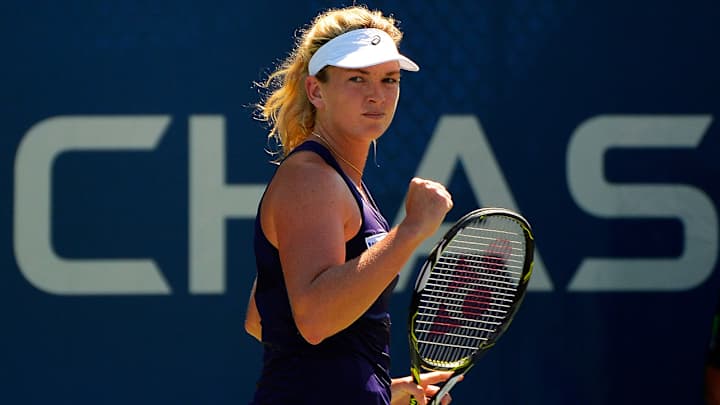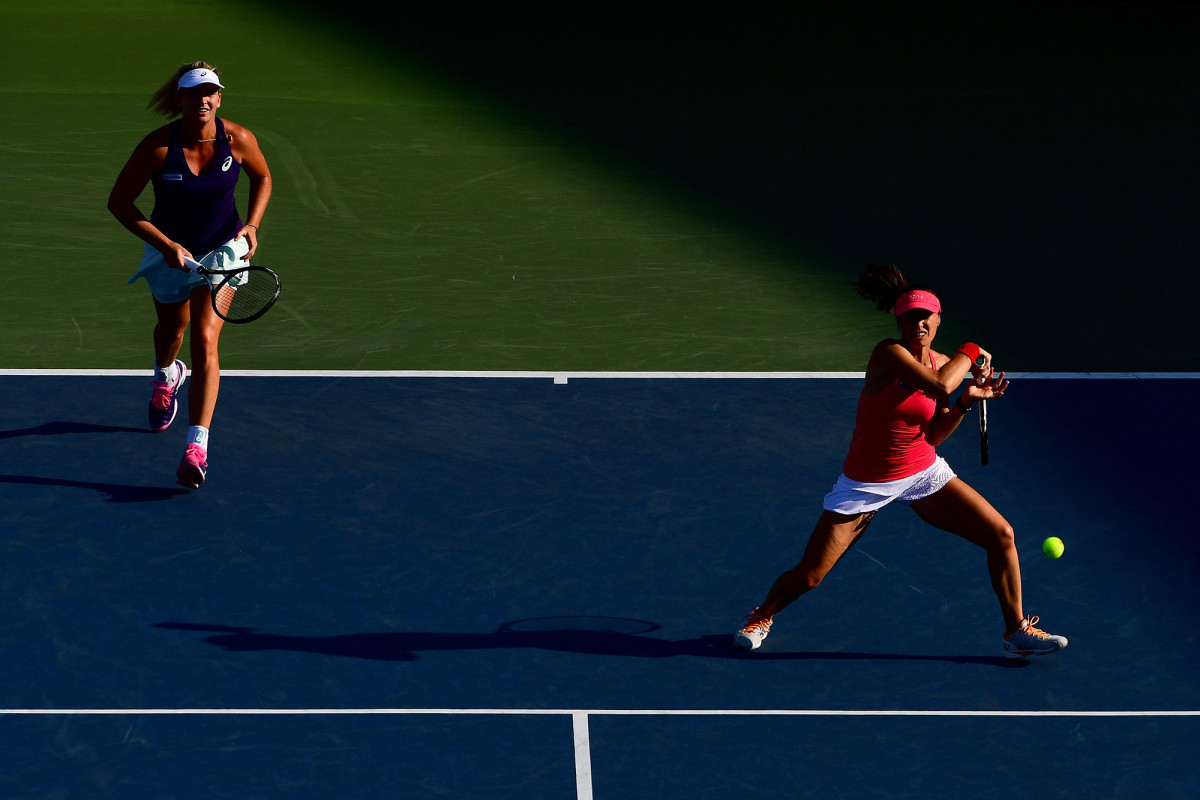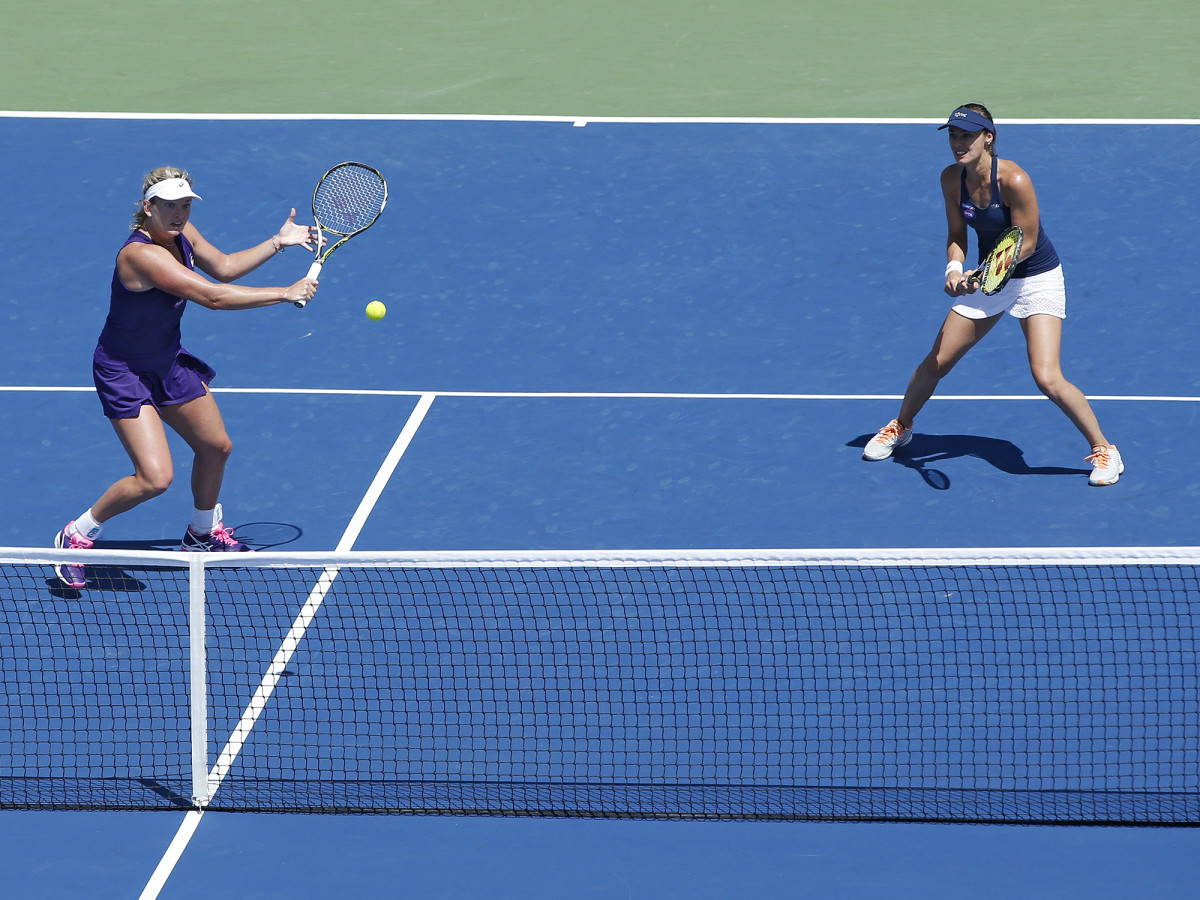Though reluctant at first, CoCo Vandeweghe is becoming a formidable doubles player

NEW YORK – CoCo Vandeweghe has a deal with her coach, Craig Kardon: If she wins a Grand Slam doubles title or reaches the quarterfinals in partner-play at all four Slams, she can retire from doubles. At the U.S. Open this weekend, Vandeweghe has a chance to carry out her end of the agreement.
“I take singles very seriously, and that’s what I want to be doing,” Vandeweghe says. “It’s quite funny—I don’t really even want to play doubles.”
Her aversion to the discipline hasn’t stopped her from winning at this year’s U.S. Open. Vandeweghe and Rajeev Ram are in Friday’s mixed doubles final, and the 24-year-old American and Martina Hingis will play in a women’s doubles semifinal on Thursday.

Vandeweghe’s potential has piqued the interest of American tennis fans since 2008, when she won the U.S. Open girls’ singles title. She’s from a sports family: Her mother, Tauna, was an Olympic athlete in both swimming and volleyball. Her grandfather played for the New York Knicks. And her uncle, Kiki, played in the NBA and now serves as the league’s vice president of basketball operations. In more than eight years as a professional tennis player, CoCo—short for Colleen—has shown flashes of brilliance, but she hasn’t yet managed to find consistent success. She has two WTA singles titles, both on grass at the Ricoh Open in the Netherlands, and in the vast majority of her Grand Slam appearances she’s fallen in the first or second rounds. She made her first Slam third round at the Australian Open in 2015, and a few months later she reached the quarterfinals of Wimbledon, falling to Maria Sharapova in three sets. At this year’s U.S. Open, she lost in the first round to Naomi Osaka.
But as her singles ranking has slowly but steadily climbed, Vandeweghe has become a formidable doubles player. Ranked No. 30 in singles, Vandeweghe entered the U.S. Open ranked No. 19 in doubles, 36 spots up from her year-end ranking in 2015. But before she started working with Kardon in 2015, she mostly stuck to singles, save for 2013, when she won four ITF doubles titles.
For defending U.S. Open mixed champs Paes and Hingis, age is nothing but a number
When Kardon told her she needed to play more Grand Slam doubles events, she initially balked. But Kardon, who has coached players like Martina Navritilova, Ana Ivanovic, Lindsay Davenport and Lisa Raymond, insisted that it would make her a better singles player.
“I think it really helps her singles because it embodies everything about her style of game—the serve, the volley, the return. Everything that she does well, the more it’s going to improve the more matches she plays, particularly doubles matches,” Kardon says. “Also, she’s not the most motivated person to get on the practice court to practice, so doubles is a way to help that.”
Kardon points out that John McEnroe, during his career, played a lot of doubles—which reduced the necessity of extra practice sessions.
“That was my trick into getting her to play doubles,” Kardon says.
Vandeweghe didn’t enjoy playing doubles at first, because she didn’t feel she jelled with her partners. She says they didn’t get her sense of humor—she describes it as “pretty sarcastic, and around my friends it gets pretty dirty”—so she never felt truly comfortable.
Wawrinka ends del Potro's uplifting run, meets Nishikori in U.S. Open semifinals
Everything started to change at Wimbledon 2015. Paired with Anna-Lena Grönefeld, Vandeweghe enjoyed herself in doubles competition for the first time. She and Grönefeld reached the third round on the grass and at the 2015 U.S. Open, the pair made the semifinals. At the start of this year, Vandeweghe expanded her repertoire into mixed doubles, playing her second professional mixed doubles match at the 2016 Australian Open, where she teamed up with Horia Tecau—who, despite starting the year as the No. 2 doubles player on the ATP Tour, was a complete unknown to Vandeweghe. When she received an offer to play with Tecau, she had to Google him.
“I saw a few shirtless pictures and he looked pretty good to me, so that’s what kind of made me say yes,” Vandeweghe says.
Tecau and Vandeweghe made the final of the Australian Open, where she also reached the quarterfinals of the women’s doubles event with Grönefeld.
“Here I was in the finals of a Grand Slam my first try,” Vandeweghe says. “So I was like, this is pretty easy!”
She didn’t have to consult Google when, earlier this summer, she received a call from an unfamiliar number. She doesn’t usually answer phone calls from unknown numbers, but Vandeweghe decided to pick up—and Martina Hingis was on the other end of the line.
Wozniacki to meet good friend and No. 2-seed Kerber in U.S. Open semifinals
A five-time Grand Slam singles champion and now the World No. 2 in doubles, Hingis needed a partner after she and Sania Mirza split. Hingis, who won three Grand Slam titles with Mirza, asked Vandeweghe if she wanted to pair up for the remainder of the year, including the Western & Southern Open in Cincinnati and U.S. Open.
Vandeweghe was already committed to other partners, so she told Hingis she’d think about it. She texted Kardon, who was shocked when he learned she hadn’t immediately accepted an offer from one of the greatest tennis players ever. A couple days later, she told Hingis she was in.
Vandeweghe, 11 years younger than Hingis, was still in elementary school when the Swiss was winning major singles titles. As a young girl, Vandeweghe attended the Acura Classic—now called the Southern California Open—and tried to get Hingis’s autograph. In the midst of a crowd, Vandeweghe was unsuccessful. She told Hingis that story this week, prompting Hingis to offer up her autograph. Vandeweghe declined.
In Cincinnati, Hingis and Vandeweghe reached the semifinals without playing a single match. (They had a bye and won two matches by walkover.) They reached the final, where they lost to Barbora Strycova and Mirza, Hingis’s former partner.
Chemistry with a doubles partner takes time. Hingis says she clicked right away with Mirza, but that it took a bit longer to develop a rapport with Vandeweghe. In the American’s first couple matches in the partnership, she struggled with self-doubt. She found herself trying to prove her worth as a partner to an all-time great player. In the second round of mixed doubles at the U.S. Open this year, when Vandeweghe and Ram toppled Hingis and Leander Paes—winners of four mixed doubles Slams the last two years—Vandeweghe felt validated in her own mind.
After losing the final in Cincinnati, Vandeweghe and Hingis realized that they weren’t communicating well. Hingis told Vandeweghe she regretted not taking a larger hand in offering advice during the match, and likewise, Vandeweghe said she didn’t feel comfortable speaking up to Hingis. But Vandweghe and Kardon assured Hingis that she was welcome to impart as much wisdom as she could spare.
“I want to learn not only from her as a tennis player but also to understand angles, positioning and things like that,” Vandeweghe says.
Hingis and Vandeweghe seem more comfortable together with each point they play. After needing three sets to fend off two of their first three U.S. Open opponents, the duo seems to be finding its groove. On Wednesday, they dominated Barbora Krejcikova and Katerina Siniakova, beating them 6-1, 6-2 to advance to the semifinals. For an hour on Grandstand, it was all high-fives and smiles.
“I think we just trust each other more now. We know the shots that we can produce,” Hingis says. “And that’s why today we were just so much more solid in everything we did, because it was just start clicking right away.”
Adds Vandeweghe: “She has a really fiery competitiveness about her, which I appreciate, because I’m very similar in that manner. I want to win and she definitely does or else she wouldn’t be playing…I think to play with a living legend is unreal.”

Vandeweghe’s game is well-suited for doubles. One of the WTA’s biggest servers, she’s sharp at the net and aggressive with her groundstrokes. Kardon believes her participation in doubles will help her become more consistent with her groundstrokes, find new ways to move the point around, improve her net game and better her first-serve percentage. He also thinks the pressure of having a partner will force her to refine her return, which is already strong.
Though she was skeptical of doubles, Vandeweghe now sees the value of playing—not just for the extra time on the court, but also to learn from Hingis. Vandeweghe admires Hingis’s work ethic at practice, and the way she never allows a rally to die, even when a shot goes long or wide. She appreciates Hingis’s advice during matches as well: sometimes, Hingis says, a 120 miles per hour serve isn’t necessary and a less powerful serve with more precision might be more effective.
Kardon called her partnership with Hingis a “perfect situation” for Vandeweghe to improve her tennis.
Backed by her belief, Kerber finds solution to Vinci's complex game to reach semifinals
“Martina knows the court. She knows strategy and tactics, and can change it. She sees things before other players do. She knows what’s going on out there before any of the other players do,” Kardon says. “And she can tell CoCo these things. CoCo’s already gotten better at reading the situation. Her strategy has gotten better as the tournament has progressed.”
Kardon thinks doubles could make Vandeweghe into a top–20 or even top-10 player. So what about that player-coach agreement?
“I will honor that, but I think she’ll want to play doubles. Why would you turn down that much money and the opportunity to win more Grand Slams? I don’t think she’ll do that,” Kardon says. “I’ll give her the choice. But she doesn’t have a choice right now. I’m making her do it.”
He later added: “With the doubles, as much as she whines about it and I know it bugs her, she’s having more success. Because it bothers her, I think she’ll be more motivated to do better at singles.”
For Gael Monfils, U.S. Open quarterfinals an opportunity to continue redefining career
If Vandeweghe wins a title this weekend, don’t count on her pulling a Flavia Pennetta. A trophy ceremony doubles retirement announcement isn’t going to happen. (“I think Martina would kill me if I did that, and Craig too,” she says.)
Kardon, a frequent target of Vandeweghe’s jokes, uses her soaring doubles ranking as ammunition to fire back.
“Yeah, you’re doubles ranking is way higher than singles,” he teases her. “You’re a doubles specialist!”
He hopes Vandeweghe will prove him wrong.
